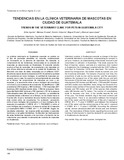| dc.rights.license | http://creativecommons.org/licenses/by-nc-sa/3.0/ve/ | es_VE |
| dc.contributor.author | Aguilar, Erika | |
| dc.contributor.author | Álvarez, Melissa | |
| dc.contributor.author | Vidaurre, Ramón | |
| dc.contributor.author | Rivera, Miguel | |
| dc.contributor.author | Lepe-López, Manuel | |
| dc.date.accessioned | 2021-05-27T04:37:25Z | |
| dc.date.available | 2021-05-27T04:37:25Z | |
| dc.date.issued | 2021 | |
| dc.identifier.issn | 0798-2259 | |
| dc.identifier.uri | http://www.saber.ula.ve/handle/123456789/47451 | |
| dc.description.abstract | La práctica veterinaria en Guatemala presenta un cambio en
el tipo de pacientes atendidos en consulta, contemplando
un incremento en la atención de mascotas. No obstante, la
comprensión de las tendencias involucradas en la consulta de
mascotas es desconocida en Guatemala. El presente estudio
explora el flujo de consultas, de propietarios y de mascotas en
una clínica veterinaria ubicada en la ciudad de Guatemala. Se
describió una base de datos compilada con el software QVET
durante los meses de abril a diciembre 2.019. Se estimó la cantidad
de propietarios por sexo biológico, la cantidad de mascotas por
especie, sexo y raza. Se exploró el comportamiento de consultas
en el tiempo, las proporciones de mascotas por sexo y por
especies, y la asociación entre el sexo biológico del propietario
con el sexo y con la especie de la mascota. Se identificaron 1.290
propietarios (797mujeres y 493 hombres), 1.753 mascotas (931
hembras y 822 machos) siendo éstos, 1.592 de la especie Canis
lupus familiaris (842 hembras y 750 machos) y 161 de la especie
Felis silvestris catus (89 hembras y 72 machos). La cantidad de
consultas tiende a disminuir en el tiempo, en los meses hacia el
final del año. El perro domestico de sexo hembra fue la mascota
más común entre los propietarios. Se evidenció asociación
entre el sexo biológico del propietario y el sexo biológico de la
mascota (Ji-cuadrado = 3.6619, df = 1, P=0,05567) y entre el
sexo biológico del propietario y la especie animal de la mascota
(Ji-cuadrado=3,7803 = 3.7803, df = 1, P= 0,05186. Según los
resultados obtenidos, las mujeres están asociadas a mascotas
hembras y a los gatos domésticos. Se discuten las implicaciones
de estas tendencias respecto a los servicios y formación de los
veterinarios para atender la demanda de consulta de mascotas
en Guatemala. | es_VE |
| dc.language.iso | es | es_VE |
| dc.publisher | SaberULA | es_VE |
| dc.rights | info:eu-repo/semantics/openAccess | es_VE |
| dc.subject | Perro | es_VE |
| dc.subject | Gato | es_VE |
| dc.subject | Especies menores | es_VE |
| dc.subject | Sexo biológico | es_VE |
| dc.title | Tendencias en la clínica veterinaria de mascotas en Ciudad de Guatemala | es_VE |
| dc.title.alternative | Trends in the veterinary clinic for pets in Guatemala City | es_VE |
| dc.type | info:eu-repo/semantics/article | es_VE |
| dcterms.dateAccepted | 01/02/2020 | |
| dcterms.dateSubmitted | 15/10/2020 | |
| dc.description.abstract1 | Veterinary practice in Guatemala presents a change in the type
of patients attended in consultation, contemplating an increase in
pet care. However, an understanding of the trends involved in pet
consultation is unknown in Guatemala. This study explores the
flow of inquiries, owners, and pets at a veterinary clinic located
in Guatemala City. A database compiled with the QVET software
from April to December 2,019 was described. The number of
owners by biological sex, the number of pets by species, sex, and
the breed was estimated. The behavior of queries over time, the
proportions of pets by sex and by species, and the association
between the biological sex of the owner with the sex and with
the species of the pet was explored. One thousand two hundred
ninty owners (797 women and 493 men), 1,753 pets (931 females
and 822 males) were identified, these being one thousand five
hundred ninety and two of the species Canis lupus familiaris (842
females and 750 males) and 161 of the species Felis silvestris
catus (89 females and 72 males). The number of consultations
tends to decrease over time, in the months towards the end
of the year. The female domestic dog is the most common pet
among owners. There is an association between the biological
sex of the owner and the biological sex of the pet (X-squared =
3.6619, df = 1, P-value = 0.05567) and between the biological
sex of the owner and the animal species of the pet (X- squared
= 3.7803, df = 1, P-value = 0.05186). According the obtained
results, women wereassociated with female pets and domestic
cats. The implications of these trends regarding the services and
training of veterinarians to meet the demand for pet consultation
in Guatemala are discussed. | es_VE |
| dc.description.colacion | 186-191 | es_VE |
| dc.description.email | malepelopez@gmail.com | es_VE |
| dc.identifier.depositolegal | pp199102ZU46 | |
| dc.identifier.edepositolegal | ppi201502ZU4665 | |
| dc.identifier.eissn | 2477-944X | |
| dc.publisher.pais | Venezuela | es_VE |
| dc.subject.institucion | Universidad del Zulia (LUZ) | es_VE |
| dc.subject.institucion | Universidad de Los Andes (ULA) | es_VE |
| dc.subject.keywords | Dog | es_VE |
| dc.subject.keywords | Cat | es_VE |
| dc.subject.keywords | Minor species | es_VE |
| dc.subject.keywords | Biological sex | es_VE |
| dc.subject.publicacionelectronica | Revista Científica | |
| dc.subject.seccion | Revista Científica: Artículos | es_VE |
| dc.subject.thematiccategory | Medio Ambiente | es_VE |
| dc.subject.tipo | Revistas | es_VE |
| dc.type.media | Texto | es_VE |


